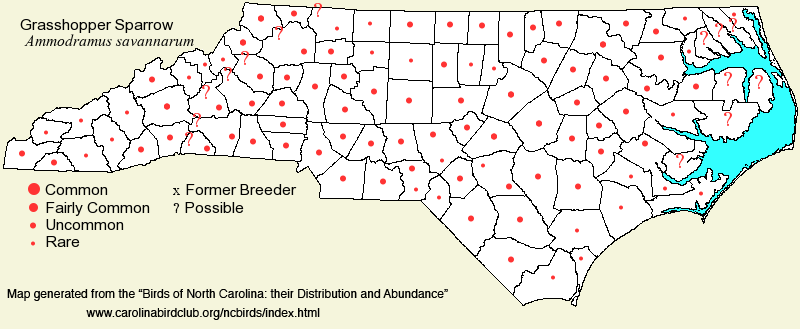 |  |
|
Grasshopper Sparrow - Ammodramus savannarum PASSERELLIDAE Members: | Search Common: Search Scientific: |
|
|
|||||||
| General Comments | The Grasshopper Sparrow is another sparrow that breeds from the Atlantic to the Pacific, but it nests in temperate areas in the United States and southern Canada, and it is not a common bird in much of the eastern United States. As expected for a grassland bird, numbers of the species are undergoing a significant decline, and this includes the population in North Carolina. In North Carolina, it breeds across most of the state, except for near-coastal areas, but is quite local in many areas. It winters, quite secretively, in the Coastal Plain from North Carolina to Texas, and southward. As a breeder, it nests in pastures, airport grassy margins, and other fallow fields; these habitats are being developed, or are becoming overgrown with abandonment, owing to a decline in livestock farming. In winter, it favors dense grassy fields (as opposed to weedy fields dominated by composites), such as recent clearcuts, wide powerline clearings, and other recently cleared/disturbed areas. Because it is highly secretive in winter, its distribution and abundance at that season is quite poorly known. | ||||||
| Breeding Status | Breeder | ||||||
| NC BRC List | Definitive | ||||||
| State Status | W | ||||||
| U.S. Status | |||||||
| State Rank | S3B,S1N | ||||||
| Global Rank | G5 | ||||||
| Coastal Plain | Summer resident in most of the region, and scarce winter resident; declining. In summer, uncommon over most of the western and central portions of the region; rare and local in coastal counties, such as at the Wilmington airport and in central Carteret, but does not nest on coastal islands. Migrants can appear on coastal islands, but are scarce. In winter, seemingly rare (could be uncommon, but poorly known) in the southeastern half of the province, including the Tidewater zone and in the Sandhills; very rare in the northwestern portions. Undoubtedly overwinters, as evidenced by one photographed in the Sandhills Game Land (Scotland) on 15 Jan and 18 Feb 2023. Mainly mid-Apr to Oct, with departure dates poorly known. Peak counts: 11, Alligator River NWR, 8-9 Feb 2001. | ||||||
| Piedmont | Summer resident, with a few winter stragglers; declining. In summer, rare to uncommon across the region, except uncommon in the southwestern portion; formerly uncommon to fairly common in the province, but rare in some counties that are highly developed. Stragglers occur into early winter, essentially in the eastern and southern portions only, but few if any overwinter. Mainly mid-Apr to Oct. Peak counts: | ||||||
| Mountains | Summer resident; declining. Rare to locally uncommon (formerly uncommon but widespread) over the region, being more numerous (uncommon) in the northern counties (Ashe and Alleghany); mainly below 3,000 feet, and very rarely to 4,500 feet. A few winter records, mainly in wide valleys in the southern counties, but does not overwinter. Mainly mid- or late Apr to Oct (departure dates poorly known). Peak counts: | ||||||
| Finding Tips |
Still can be heard and seen reliably in a few places; the two large Voice of America fields in southeastern Pitt and northwestern Beaufort are good places. ** to *** | ||||||
| Attribution | LeGrand[2023-05-19], LeGrand[2023-03-31], LeGrand[2018-02-02] | ||||||
| NC Map Map depicts all counties with a report (transient or resident) for the species. | Click on county for list of all known species. |
| NC Breeding Season Map Map depicts assumed breeding season abundance for the species. |  |